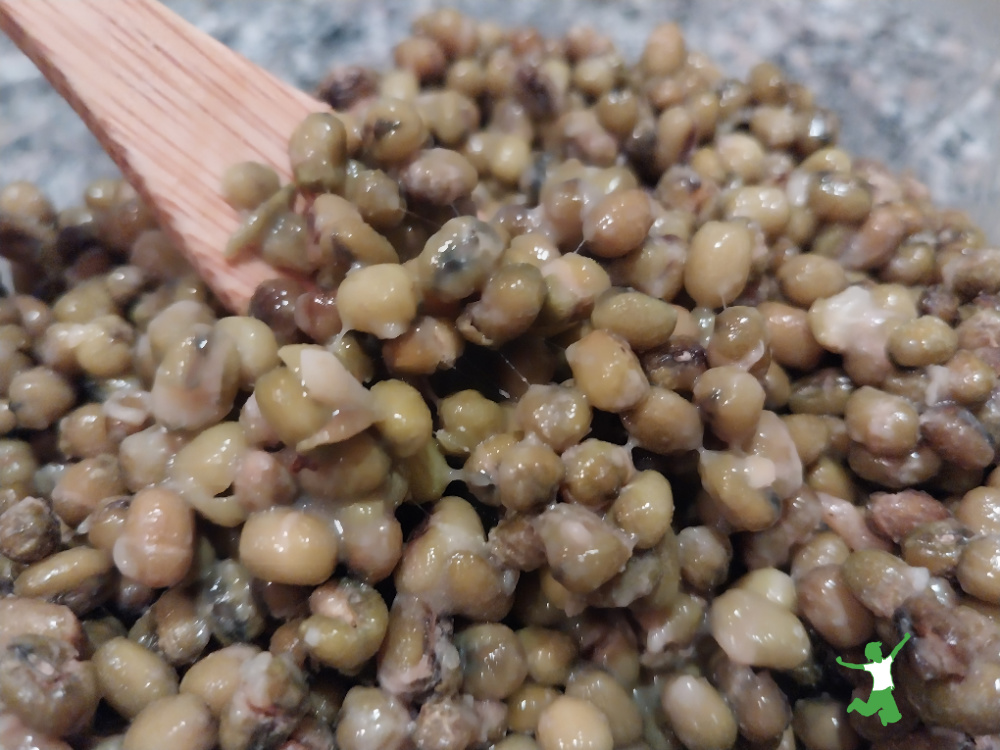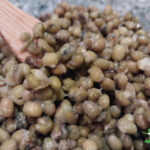Table of Contents[Hide][Show]
How to make soy-free natto at home easily and inexpensively that is rich in Vitamin K2 and therapeutic soil-based probiotics.

Natto is a critical traditional food to include in your diet, yet most traditional foodies ironically have never tried it.
Natto is a form of fermented soy and is one of the few (only?) cultured foods that contains a beneficial, soil-based bacterium.
In the case of natto, it is the powerful gut cleanup crew known as Bacillus subtlis.
Tempeh and miso also contain soil-based microbes, but they are the molds Rhizopus orzae and Aspergillus oryzae, respectively, which can cause allergic issues for some people.
Kefir made with live grains (not powder starter) contains dozens of strains of beneficial bacteria and candida-busting yeasts. Surprisingly, none of these strains are soil-based according to my research.
Thus, it may come as a surprise that eating a variety of fermented foods but excluding natto will likely leave a huge gap in your probiotic experience.
Soil-based bacteria are very important for gut restoration (aka, healing leaky gut) as well as optimal intestinal maintenance.
For example, those on the GAPS diet will likely plateau in their healing journey if they don’t either eat natto or take a therapeutic SBO probiotic (I suggest this brand).
Since SBO probiotics are some of the most expensive on the market, it is a good idea to make natto yourself.
You will save a bundle!
I actually love the taste of natto and eat 1-3 tablespoons of my homemade soy-free versions most days.
Word to the wise…natto is definitely an acquired taste! Most people do not like it at first!
The slimy texture takes some getting used to also. The experience of natto on the tongue is not a common sensation in Western dishes!
I prefer to eat soy-free natto made from fermented mung beans (you can use other types of legumes if desired).
Mung bean natto visually and texturally best mimics premium small soybean organic natto…at least to my palate!
If you wish to eat natto regularly like I do, using a legume other than soy is wise. Many people do not realize that soy is still thyroid suppressing even if fermented.
Bonus! Natto not only contains elusive soil based organisms (SBOs). It also contains more Vitamin K2 than any other food!
Wait, there’s more!
Eating natto provides the body with ample amounts of the important enzyme nattokinase, which has numerous health benefits and is useful for naturally treating a wide variety of conditions. (1)
Only 2 tablespoons of natto contains roughly 220 mcg of MK-7 (the fermented form of Vitamin K2).
So making your own natto and eating it regularly may permit you to forgo Vitamin K2 supplements as well.
Preparation Tip
I do not recommend making natto with any type of sprouted legume.
The results turn out mushy!
The consistency and texture of soy-free natto turn out the best when you soak your unsprouted legume of choice overnight, cook until just soft, and then initiate the fermentation process while the beans are still warm.

Homemade Soy-free Natto
How to make natto at home easily and inexpensively with mung beans instead of estrogenic soybeans.
Ingredients
- 1 cup dried mung beans unsprouted and organic
- filtered water
- 1 packet natto spores
Instructions
-
Rinse mung beans and place them in a large glass bowl. Cover with enough filtered water to allow the beans to roughly double in size as they expand. Leave on the counter for 8 hours or overnight.
-
Drain the soaking water and place beans in a large pot. Cover with fresh filtered water.
-
Bring the beans to a boil, turn down the temperature to a simmer, affix the lid and cook the beans for about 20 minutes until just soft but not mushy (do not overcook!).
-
Drain the beans and place in a large VitaClay slow cooker or crockpot. The beans should be no more than 1" in depth. Discard any beans that may accidentally spill during the transfer from the pot to a VitaClay (or other slow cooker).
-
Let the beans cool for 10 minutes in the Vitaclay.
-
While the beans are cooling slightly, dissolve a packet of natto starter in 3 Tbsp of warm filtered water.
-
Pour the natto spore solution over the cooled but still warm beans. Stir gently to mix with a clean, bamboo spoon.
-
Place the lid on the VitaClay and select the "yogurt" setting.
If using a different type of slow cooker, use the setting that will keep the beans between 100-110 °F/ 38-43 °C which is the temperature range necessary to ferment the beans into natto.
-
After 24 hours, turn off the Vitaclay, remove the lid, and cool the natto to room temperature for 1 hour. A whitish film and an ammonia-like aroma means they are done. The beans will also have a stringy and slimy appearance (see photo above).
-
Place the cooled natto in a glass container with a tight-fitting lid and refrigerate.
-
Natto will be ready to eat once refrigerated overnight. It will last for months, and the flavor will age and strengthen with time.
-
Mung beans contain less than 1% of the isoflavones in soy. Thus, feel free to eat 1-3 tablespoons per day of mung bean natto for an inexpensive and tasty soil-based probiotic and Vitamin K2 food source.

(1) Health Benefits of Natto








Update :
After it cooled, I began scooping it out and discovered that though it was very dry on top it was slimy and moist underneath.
What if it has the ammonia smell but is quite dry on top, not slimy or whitish ?
Sounds like it may have partially fermented, perhaps? Use your best judgment.
I am just wanting to confirm that natto made from mung beans is NOT thyroid suppressing ?
Thank you for clarifying this for me.
And I agree, it would be a great money saver if a new batch could be made from the starter of the old batch, not to mention if a break down in our system occurs and we can no longer get the packets of natto spores. In a case like that being able to make it with your homemade starter would be a life saver.
Mung beans are NOT goitrogenic and are are good legume choice for a thyroid friendly diet.
Sarah, do you know of a natto that is made from legume that you can order online? I can’t seem to find anything! Thanks!
I only know of soy natto that is available to buy. Soy-free natto you must make yourself. Hopefully this will change in the future!
Sarah
I made the natto per your instructions. I have a 7700 model of the Vitaclay so there’s no yogurt setting. I put it on the warm setting because everything else would have just cooked it. It did not have any slime or ammonia smell. I’m assuming it is not fermented but could I still eat it?? Also do you know which setting would work on that model? I called Vitaclay but they have not called me back. Thank you!!!!!
The warm setting on a Vitaclay is far too high (above 110 F) so the probiotics were destroyed in the starter.
If it didn’t ferment properly, do not eat it. I would recommend using a Vitaclay (or crockpot) that has a yogurt setting as it is critical for success of the recipe to have the proper temperature.
I’d been wanting to try making Natto for some time and your recipe gave me the confidence to try, thanks so much. When I looked it up, my Crock Pot slow cooker seems to have too high a temperature even on low, so I gave it a go in my Instant Pot using the Yoghurt ferment setting for 24 hours. I had white slime and a fair amount of stringy bits so it seems to have worked, only thing is I can’t smell it! Also the taste seems absolutely fine to me and not something strong or strange that I would need to get acquired too, which is making me wonder if it really has worked as it should?? Or has my 61 yr old sense of smell and taste just become too weak?
If you saw the white film and stringy slime and couldn’t smell the ammonia-like smell, my guess is that your sense of smell is impaired somehow. It is very strong!
Glad you don’t mind the taste. It is also quite strong and takes some getting used to. I love it now!!
Sarah, maybe a funny question, but how do you eat natto? Just eat it by the spoonful, use as a topping for something? Can you describe the taste?
I eat it off the spoon. Natto fried rice is a good recipe if you want it as part of a dish. https://www.thehealthyhomeeconomist.com/natto-fried-rice-nutrient-dense-meal-on-the-cheap/
The taste is unlike anything else I’ve ever tried, so cannot describe within the context of another food.
Sarah, great information as always!
I’m already an intermittent natto consumer and your recipe looks interesting to me because it doesn’t use soy.
I don’t have a Vita Clay Pot or slow cooker but I’m wondering if I could substitute my Excalibur dehydrator for those in the recipe because it has low temperature settings, too.
Thanking you in advance for your reply. Suzanne
That is an interesting idea. I don’t know if it would work as I have not tried it myself.
If you try your dehydrator to make this recipe, please circle back and let us know the results!!
Yes, please let us know. I know that dehydrators work well for yogurt. They are nice because you can make the yogurt in the jars you plan to store it in.
Wow! This is awesome! I was thinking of making this! Can’t wait to make this!
What do you think about making it with black beans?
Black beans work great!
Sarah – Can you use the natto itself as a starter for subsequent batches? Or do you use a new packet of natto spores each time you make it? Thanks – Katie
Yes, it should theoretically work, but I don’t know how much to use yet to ensure the batch does not fail.
When I do, I will update this post to suggest the right amount that is needed.
I had this same question. Thanks for asking, Katie! Thanks for following up, Sarah!
Same question. Looking forward to the reply.
Yes, same question. I have wanted to try making natto for a long time, but keeping a culture going would be the key. Then it would really save money, and I could add it into our routine, like sourdough.